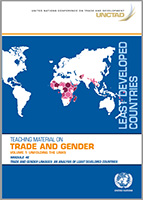Women across countries and regions face many obstacles that hamper their capacity to fully benefit from international trade and more generally from their participation in the economy.
In the case of Least Developed Countries, such obstacles are magnified by persistent and acute development challenges that include high levels of poverty, deficient infrastructure, limited productive capacities, and a mostly low-skilled labour force. Structural transformation and a fruitful integration into the global economy are still quite limited in most LDCs, despite many years of duty-free, quota-free access to some major international markets and aid commitments by donor countries.
This joint UNCTAD-EIF publication discusses the gender implications of international trade and regional/global economic integration in the LDCs. It examines the socio-economic outlook of LDCs and existing gender inequalities through country perspectives, and puts forth policy recommendations. It covers 47 countries from different geographical regions (33 from Africa, 9 from Asia, 4 from the Pacific, and 1 from the Caribbean).
This publication is part of a portfolio of case studies prepared by UNCTAD in the framework of its capacity building initiative on trade and gender. It is also the basis for an online course on trade and gender specifically dedicated to the LDCs context.


